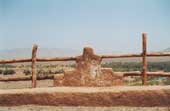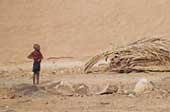 About Our Trip About Our Trip
This is the route we’ll drive down to the reach the Sahara.
We’ll have a meal in Agdz before entering the Draa Valley.
Driving along the oasis of Zagora we’ll reach Tamgroute where we’ll visit Librairie Coranique.
Then driving along the Tinfou Dunes, through M’Hamid we’ll have a last stop in Tagounite before reaching the edge of the Sahara.
 About Zagora etc About Zagora etc
The Dades is called Country of the Figs to distinguish it from the drier Draa, known as Country of the Dates. When travelling down the Draa you start off in Ouarzazate. The road from Ouarzazate to Zagora takes you at first through the grandeur of the peaks and ridges of the Djebel Sarhro range to the main pass at Tizi n'Tinififft. Rising in the High Atlas, the River Draa cuts a deep channel between Djebel Sarhro and the Anti Atlas ranges through a series of precipitous canyons famous for their cliffs of green and black rock.
At Agdz, you emerge from the mountains to catch a first, extraordinary glimpse of the Draa Valley and the oases - a thick streak of palms reaching, and the first sign of the Draa kasbahs, rising as if from the land where the green gives way to the Desert. The Draa valley is a more than 100 kilometres long belt of date palms. You follow the river, which goes through one big plantation, normally some 20 metres wide on both sides of the riverbank, before the desert takes control. All the way, small irrigation systems secures the survival of the palms, and more important, the people living of the crops. Some few people live there next to the mountains, and a river disappearing gradually while you make the journey down to the desert. The inhabitants of the Draa Valley are a mixture of Arab, Berber, Jew and the descendants of Mauritanian slaves. Under constant attack from marauding nomads, they clustered together in fortified villages called Ksours, surrounded by their quilt of minutely divided fields and palm groves. Like tiny city-states, the still thriving communities built everything vital to life within their protective walls. Every now and then, you pass a small village, where the modern age hasn’t had any impact. In these places, all women are veiled and dressed in clothes with patterns changing from village to village. Even the men are somewhat suspicious towards you.
You’ll also cross Tamgrout, a slightly bigger village, which has for long been the centre of religious education in the Islamic countries. Today it houses a koranic library, which contains some of the oldest manuscripts of Arabia.
After Zagora, true desert starts, but only slowly. A single dune is standing out from the stone desert, and you wonder if it's real or not. And it is. Actually you have you ride all the way to M'hmid passing Tagounite and then continue some kilometres before endless dunes cover the whole horizon. |



